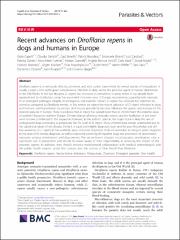Recent advances on Dirofilaria repens in dogs and humans in Europe

View/
Date
2018-12Author
Capelli, Gioia
Genchi, Claudio
Banet, Gad
Bourdeau, Patrick
Brianti, Emanuele
Cardoso, Luís
Danesi, Patrizia
Fuehrer, Hans-Peter
Giannelli, Alessio
Ionica, Angela Monica
Maia, Carla
Modrý, David
Montarsi, Fabrizio
Krücken, Jürgen
Papadopoulos, Elias
Petrić, Dušan
Pfeffer, Martin
Savić, Sara
Otranto, Domenico
Poppert, Sven
Silaghi, Cornelia
Metadata
Show full item recordAbstract
Dirofilaria repens is a nematode affecting domestic and wild canids, transmitted by several species of mosquitoes. It
usually causes a non-pathogenic subcutaneous infection in dogs and is the principal agent of human dirofilariosis
in the Old World. In the last decades, D. repens has increased in prevalence in areas where it has already been
reported and its distribution range has expanded into new areas of Europe, representing a paradigmatic example
of an emergent pathogen. Despite its emergence and zoonotic impact, D. repens has received less attention by
scientists compared to Dirofilaria immitis. In this review we report the recent advances of D. repens infection in dogs
and humans, and transmission by vectors, and discuss possible factors that influence the spread and increase of this
zoonotic parasite in Europe. There is evidence that D. repens has spread faster than D. immitis from the endemic areas
of southern Europe to northern Europe. Climate change affecting mosquito vectors and the facilitation of pet travel
seem to have contributed to this expansion; however, in the authors’ opinion, the major factor is likely the rate of
undiagnosed dogs continuing to perpetuate the life-cycle of D. repens. Many infected dogs remain undetected due to
the subclinical nature of the disease, the lack of rapid and reliable diagnostic tools and the poor knowledge and still
low awareness of D. repens in non-endemic areas. Improved diagnostic tools are warranted to bring D. repens diagnosis
to the state of D. immitis diagnosis, as well as improved screening of imported dogs and promotion of preventative
measures among veterinarians and dog owners. For vector-borne diseases involving pets, veterinarians play a
significant role in prevention and should be more aware of their responsibility in reducing the impact of the
zoonotic agents. In addition, they should enhance multisectorial collaboration with medical entomologists and
the public health experts, under the concept and the actions of One Health-One Medicine.
